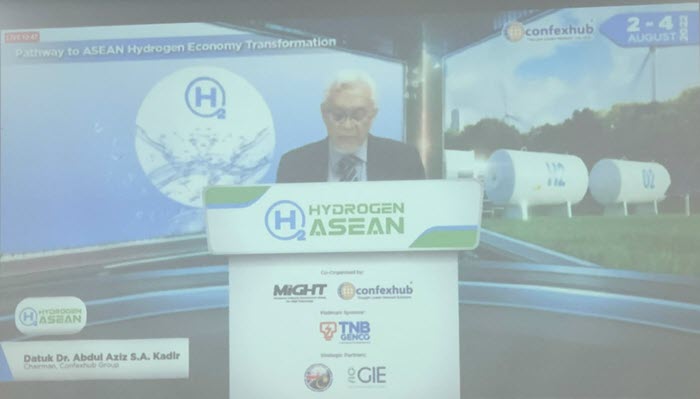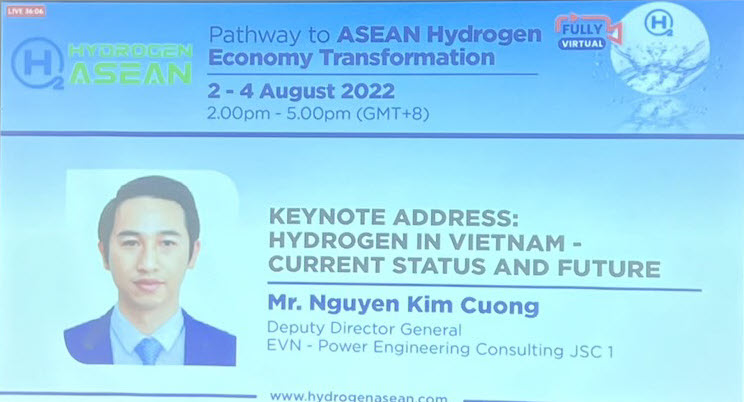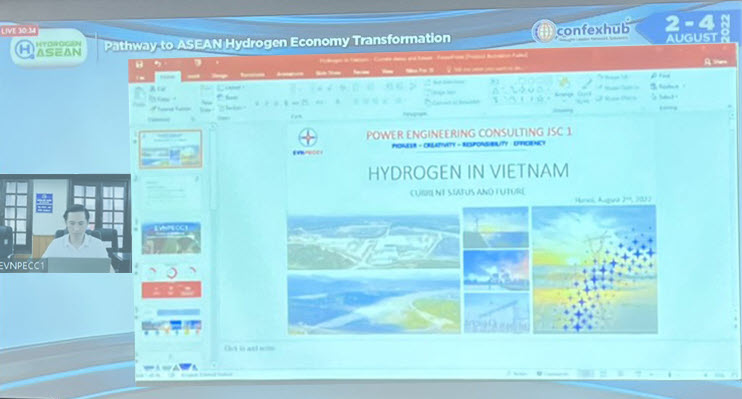The Summit was organized to bring together policymakers, industry leaders, power producers, carbon capture and storage experts, hydrogen producers and green technology suppliers with the goal of sharing insights into the ASEAN hydrogen economy pathway.
The development of the hydrogen economy is aimed at enabling countries to effectively achieve a deep decarbonization strategy, assisting countries in achieving their climate goals, while promoting green growth and creating sustainable cities, industrial sectors and jobs.

Dr. Abdul Aziz S.A. Kadir – Chairman, Confexhub Group delivered the opening speech at the Summit
It's time for Southeast Asian countries to exploit the potential of hydrogen, making hydrogen an environmentally friendly, safe, and affordable energy to open up new opportunities in the energy sector, transportation, mining, and industry. This Summit aimed to enhance understanding and share experiences for policymakers when setting frameworks and roadmaps; guide industries to open up opportunities, and develop business plans and strategies, and for funding agencies and the financial services industry to promote clean hydrogen projects through green financial instruments and funding mechanisms.
Due to its mobility and environmentally friendly nature, hydrogen is making a significant turning point in the transition of clean energy as a net zero emission fuel in the transportation, construction, and power generation sectors. Advances in carbon capture, use, and storage technologies, and continued reductions in production costs along with decarbonization policies worldwide, have led to large consumption of clean hydrogen in mining and industrial sectors. In the Hydrogen Insights 2021, governments globally have committed more than $70 billion to more than 200 projects and committed to more than 30 roadmaps and policies. The global hydrogen energy demand has grown on a trajectory and is targeted to reach 530 million tons per year by 2050. What future for Southeast Asian countries? And, what are the implications of not having a hydrogen strategy in Southeast Asian countries' growth goals? Those questions will be discussed at this Summit.

Mr. Nguyen Kim Cuong – Deputy General Director of PECC1 on the main screen of the Summit
In his presentation on the first day of the Summit, Mr. Nguyen Kim Cuong said: The UN Climate Change Conference 2021 (COP26) has brought great hope when so many countries have a strong commitment to promoting the reduction of greenhouse gas emissions; Through that, Vietnam has committed to invest in sustainable green energy and green hydrogen being one of the key issue prioritized by the Vietnamese government. Under Decision No. 888/QD-TTg of Vietnam dated July 25, 2022, the Prime Minister set out tasks such as: Actively participating in the global trend of low-carbon development, resources mobilization, and technological innovation to transform growth models. Develop and implement tasks and comprehensive solutions to respond to climate change and energy transition in order to fulfill the commitment to achieve "net zero" emissions by 2050. By 2030, encouraging the use of electricity and green energy in transportation; reducing greenhouse gas emissions by 32.6% in energy, 43% in agriculture, and 70% in forestry. Thereby, proposing a number of solutions such as focusing on developing renewable energy projects (solar power, offshore wind power, hydropower, tidal energy, biomass energy, etc.); researching, developing and using green ammonia fuel, green hydrogen; storing energy and developing carbon capture, storage and utilization technologies.
Also, in the presentation, Mr. Nguyen Kim Cuong presented information on the current status of hydrogen production in Vietnam from petrochemical and fertilizer refineries, as well as the current status and demand forecast for hydrogen and ammonia in Vietnam's industries by 2035. Besides, he also said, the actual operation of Vietnam's electricity system shows that when the proportion of renewable energy accounts for a high percentage in the system, it leads to an imbalance in electricity source distribution throughout the country. Disadvantages regarding the time of maximum generating capacity of the energy source with the peak load: for example, the difference between the strongest solar generation on Sunday noon (low demand) and the peak load on Monday evening. Due to the limitation of inter-domain transmission and the power reserve requirement for the system, there are many milestones when the system cannot absorb all the available capacity of renewable energy. Therefore, energy storage and transmission are an issue that Vietnam needs to pay attention to, with the focus of which is research on green hydrogen.

The presentation delivered by Mr. Nguyen Kim Cuong on the topic " Hydrogen in Vietnam - Current status and future"
Mr. Nguyen Kim Cuong also released that, with the goal of contributing to ensuring national energy security and in the context of domestic oil and gas production gradually decreasing, Vietnam's draft power development planning (PDP) VIII shows that various traditional thermal power plants will be converted to hydrogen and ammonia consumption. Therefore, Vietnam needs to clarify legal issues, specific conversion goals and energy conversion roadmap for green hydrogen and the need to upgrade the transportation logistics system for hydrogen and ammonia.
Being the only Vietnamese speaker at this Summit of the Deputy General Director of PECC1 shows that Power Engineering Consulting Joint Stock Company 1 is always a pioneer in catching up with new trends and technologies of the world. This is also a positive signal that PECC1 determines to fulfill its commitment to integration, international market expansion, sustainable development, and brand value enhancement, and continues to affirm its leading position in the energy consulting services in Vietnam as well as other countries in the region.
The Summit will last 2 days more with the main topics as follows:
- Session one: The hydrogen future is here – inexpensive, net-zero and safe
- Session two: Hydrogen in the power utility sector
- Session three: Hydrogen and fuel-cell in mobility
- Session four: Green hydrogen trajectory in industrial applications